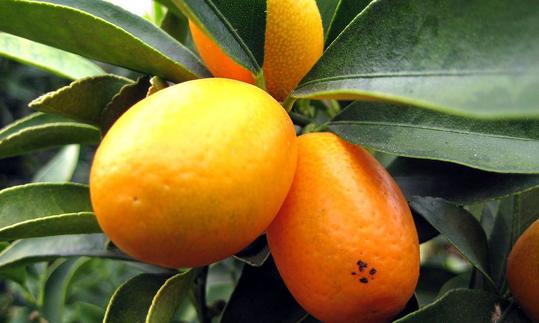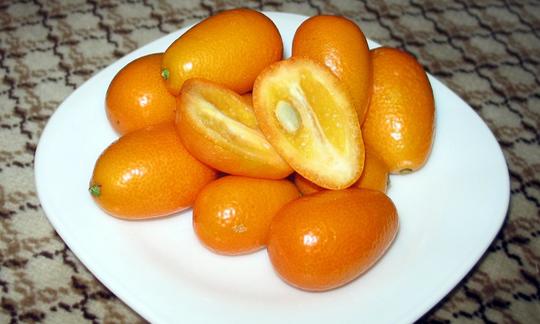Table of contents
The Kumquat ( Fortunella Swingle, Citrus japonica), also called mini orange, dwarf orange or dwarf bitter orange, comes from Asia and is one of the citrus fruits.
Use in the kitchen
What is a mini orange? The kumquat is an elongated fruit the size of a gooseberry. It comes in round and oval shapes. Its color is bright yellow-orange. The dwarf bitter orange is a mini orange that can be eaten with the peel and seeds.
What do kumquats (mini oranges) taste like? The firm skin of the kumquat tastes sweet and orangey, with a slightly bitter note. The flesh, on the other hand, is astringent, bitter and sour. The flesh has six segments in which the edible seeds of the fruit are located. The aroma of the kumquat is unusual when you eat the fruit raw as fresh fruit. You expect sweetness rather than tartness from this delicate fruit. Nevertheless, it is worth a try.
How can you eat mini oranges? How do you eat kumquat? After washing the fruit, take it in your hand and roll it back and forth. This allows the peel to develop its special scent, becomes more sweet and loses some of its bitterness. Rolling the peel in your hand releases the essential oils from the peel. The released aromatic substances develop and the flesh of the fruit takes on a softer consistency.
The unique aroma of the kumquat means there are many possible uses. The fruit goes well with all dishes in which you can use oranges. They give a fresh fruit salad an exotic, orange-like and slightly tart aroma. Many desserts can be refined with kumquats. Even just covered in dark chocolate, the mini oranges are a particularly delicious treat.
The small fruits with the great aroma are ideal for processing into jam or compote. Instead of candied orange peel, the kumquat fruit is a good substitute in baking or cooking. Kumquats are also an excellent choice for making various drinks.
Vegan recipe for a refreshing salad with kumquat
Ingredients (4 people): 1 small iceberg lettuce, 150 g baby spinach, 150 g kumquats, 80 ml orange juice, 1 clove of garlic, 50 g walnuts, 6 tbsp balsamic vinegar (white), 1 pinch of table salt, 1 pinchof black pepper.
Preparation: Wash the iceberg lettuce and cut into thin strips. Wash the baby spinach and drain well. Wash the kumquat and cut into slices. Peel the garlic, squeeze the oranges and pour the appropriate amount of juice into a container. Add the remaining ingredients and puree with a hand blender. Dilute with orange juice to achieve the desired consistency. Season with salt and pepper as needed. Mix the vinaigrette into the salad and serve immediately.
Vegan recipes with kumquat can be found under the note: " Recipes that have the most of this ingredient ".
| Not only vegans or vegetarians should read this: Vegans often eat unhealthily. Avoidable nutritional errors. |
Purchasing - Storage
Kumquats can occasionally be found in the range of large retailers such as Migros, Edeka and Billa. Other supermarket chains such as Coop, Denner, Volg, Spar, Aldi, Lidl, Rewe and Hofer do not seem to have them in their standard range (as of 2024). Organic supermarkets such as Denn's Biomarkt and Alnatura also do not sell mini oranges. Kumquats can be bought from specialised fruit retailers or ordered from online shops.
In the DA-CH countries, kumquat is available (almost) all year round thanks to long-distance imports. The local season varies depending on the country of cultivation.
The availability of kumquats varies depending on the size of the store, catchment area, etc. Our recorded food prices for the DA-CH countries can be found above under the ingredient image - and by clicking on them you can see their development at different suppliers.
Found in the wild
The individual species of the genus Fortunella are not wild plants, but have arisen in garden cultivation. 2 All varieties originate from a single species.
Storage tips
The fruits come to the market ripe and ready to eat. You can buy them in bulk and store them in the refrigerator for two to three weeks.
Like all citrus fruits, kumquats are not climacteric. This means that they do not ripen after harvesting. At room temperature, the water evaporates quickly and the fruit shrivels. If kept at 8 to 14 °C, the fruit can be stored for four weeks, or for six weeks at 6 °C. However, cold damage can easily occur at temperatures below 8 °C. 7
Ingredients - Nutritional values - Calories
100 g of raw kumquats have an energy content of only 71 kcal. They are almost fat and protein free. With 6.5 g/100g of dietary fiber, they are rich in fiber. This corresponds to 26% of the dailyfiber requirement. Of the 16 g of carbohydrates, 9.4 g are sugar. 1
Mini oranges contain 44 mg of vitamin C per 100 g. This corresponds to 55% of the daily requirement. Currants (41 mg), pineapple (48 mg) and clementines (49 mg) have similar values. Sea buckthorn berries (450 mg), guava (228 mg) and black currants (181 mg) contain particularly high levels of vitamin C. 1
Also included are smaller amounts of potassium, folate, calcium, manganese and iron. 1
The complete ingredients of kumquat, the coverage of the daily requirement and comparison values with other ingredients can be found in our nutrient tables. In the article Nutrients explained you will get a detailed insight into the topic.
Health effects
How healthy are kumquats? Kumquats contain large amounts of vitamin C (ascorbic acid), which has an antioxidant effect. Antioxidants protect cells from oxidative stress by capturing free radicals and oxidants. Oxidative stress is caused by excessive production of reactive oxygen species (ROS), which leads to DNA damage, lipid peroxidation and oxidation of proteins (carbonyl proteins). This triggers numerous diseases, such as cardiovascular disease and cancer. 9
Since you consume kumquats with their peel, you consume more health-promoting essential oils and secondary plant substances than, for example, oranges or lemons. 10
Secondary plant substances
Many of the health effects of kumquat can be attributed to the secondary plant substances it contains. Our article on secondary plant substances provides an overview of the classification of the substance groups, their occurrence in foods and possible effects on humans.
However, it should be noted that the composition of secondary plant substances in kumquat can vary depending on the variety, time of harvest and growing conditions. Therefore, quantities are only of limited use and should only be understood roughly.
Dangers - Intolerances - Side effects
People who are allergic to citrus fruits should not eat this fruit either. If you are prone to heartburn, it is better not to eat the sour kumquat fruits too often.
Folk medicine - natural medicine
In Chinese folk medicine, kumquat is used to treat inflammation of the respiratory tract, colds and coughs. It is also said to have a protective effect on blood vessels and improve vascular permeability. 11
Ecological footprint - animal welfare
The CO 2 footprint is primarily used to assess the climate friendliness of a food. This depends on various aspects such as cultivation method (conventional/organic), seasonality, country of origin, processing, transport and, if applicable, packaging. Carbon Cloud gives a value of 0.53 kg CO 2 e/kg (cultivation only, without transport). 5
We could not find any figures for the water footprint. This is probably similar to other citrus fruits: oranges 560 l/kg, mandarins 748 l/kg, lemons 642 l/kg and grapefruit 506 l/kg. 6
For detailed explanations of various sustainability indicators (such as ecological footprint, CO2 footprint, water footprint), see our article: What does the ecological footprint mean?
Worldwide occurrence - cultivation
Kumquats originally come from southeast China. Today, kumquats are cultivated not only in Asia, but also in Argentina, Brazil, Florida, California, the Mediterranean, Australia and South Africa. 7 Since the plant is quite cold-resistant, it can be found cultivated up to 30 degrees north latitude. 3
Kumquats from Corfu are well known and have been cultivated on the Greek island since 1924. 10
As an evergreen shrub or standard tree, kumquat grows very slowly. The plant only reaches a height of 2.5 to 4.5 meters. Some of the densely branched branches have small thorns. The leaves are elongated, leathery, and have a shiny dark green color. Like other citrus fruits, kumquats also have white, fragrant flowers. A kumquat tree can produce several hundred or even several thousand fruits per year. 4
Since kumquat is a niche product, there are no statistical figures on its worldwide cultivation. 7
Cultivation - Harvest
Kumquat trees grow particularly well in areas with hot summers (25-38 °C). They are cold-resistant and can tolerate temperatures of -10 °C in winter. This means they can be grown in areas where other citrus fruits do not grow. However, kumquat trees grow better in mild areas and produce higher quality fruit. 7
In the DA-CH region, kumquats can be cultivated as houseplants in pots. They require a sunny and warm location. The substrate should be permeable and slightly acidic. Kumquats do not tolerate waterlogging. In winter, the kumquat tree needs a cool and bright location at 0 to 10 °C and hardly any water. Kumquats only bear plenty of fruit every two years. 8
Since mini oranges are eaten with the peel, the use of pesticides and fungicides is particularly delicate. After harvesting, they are bathed in hot water or exposed to UV light to kill microorganisms and prevent the fruit from rotting prematurely. 7
Further information
Kumquats are the smallest of the citrus fruits. For several decades, kumquats were classified within the Rutaceae family in the genus Citrus. This was called Citrus japonica. Walter T. Swingle reclassified them in the genus Fortunella spp. 7
This includes six species: Fortunella japinic Thunb, Fortunella hindsii Swingle, Fortunella margarita Swingle, Fortunella crassifolia Swingle, Fortunella madurensis Loiur and Fortunella polyandra Tan. 3
In China, kumquats are widespread mainly because of their decorative appearance. They are said to be mutants. A large-fruited citrus species could have evolved into an ornamental plant over thousands of years. However, this is not entirely plausible. 3
Alternative names
The name kumquat comes from the Chinese "Chin kan", which means "golden orange". 7 In China it is called Chu-Tsu, Chantu or Kinkan.
Kumquat in German is called mini orange, mini orange, dwarf orange or dwarf bitter orange.
The English name is kumquat.
Bibliography - 11 Sources (Link to the evidence)
| 1. | USDA, United States Department of Agriculture. |
| 2. | Danxiang Zhang, David J. Mabberley: Citrus japonica Thunberg, Nova Acta Regiae Soc. Sci. Upsal. 3: 208. 178. |
| 3. | Brücher H. Tropische Nutzpflanzen: Ursprung, Evolution und Domestikation. Berlin: Springer-Verlag. 1977: 345. |
| 4. | Julia F. Morton: Fruits of warm climates. Florida Flair Books, Miami. 1987: 182–185. |
| 5. | Carbon Cloud. Kumquat Sweden. 2024. |
| 6. | Mekonnen MM, Hoekstra AY. The green, blue and grey water footprint of crops and derived crop products. Hydrol Earth Syst Sci. 2011;15(5):1577–1600. |
| 7. | Palma A, D'Aquino S. Kumquat - Fortunella japonica. In: Rodrigues S, De Oliveira Silva E, Sousa de Brito E (Ed.) Exotic Fruits. 2018, 271-278. |
| 8. | Plantura.Garden. Kumquat anpflanzen & pflegen: Tipps vom Experten. |
| 9. | Biesalski HK, Bischoff SC et al. Ernährungsmedizin. 5. Auflage. Thieme: Stuttgart, 2018, 294-296. |
| 10. | Ziogas V, Ganos C et al. Chemical Analyses of Volatiles from Kumquat Species Grown in Greece—A Study of Antimicrobial Activity. Horticulturae. 2024;10(2):131. |
| 11. | Li X, Meenu M, Xu B. Recent Development in Bioactive Compounds and Health Benefits of Kumquat Fruits. Food Reviews International. 2023;39(7):4312-4332. |
- Beatrice Lippuner
- Amanda Gabriel, MA










Comments